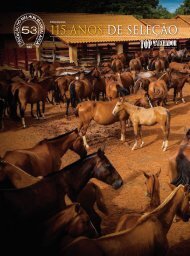livro_internet
Create successful ePaper yourself
Turn your PDF publications into a flip-book with our unique Google optimized e-Paper software.
Biodiversity - FURNAS uses natural resources being aware of the
need to conserve biodiversity, combined with the maintenance of the
safety of the energy generation and transmission system. The management
of the use and occupation of the margins of the reservoirs is of extreme
importance. The damming and the flooding of its banks cause
impacts to the local flora and fauna, as it modifies the landscape, the
use of the soil and the characteristic of the body of water. FURNAS carries
out several actions to mitigate the environmental impacts arising
from works in hydroelectric power plants, such as: erosion control, vegetation
restoration, wild fauna rescue and monitoring water quality, the
ichthyofauna (a set of fish species that exist in a region) and the terrestrial
wild fauna. Environmental studies and monitoring programs occur
during and after the constructions.
In transmission lines, preventive measures are adopted since the
definition of the tracing, avoiding interferences in protected areas and
fragments of native forest more significant. In addition, the use of high
towers and the adoption of special cable launching techniques reduce
deforestation in areas with a high degree of biodiversity. In total, 1,402
kilometers of transmission lines use tower elevation techniques, avoiding
the shallow cutting of any vegetation present in the easement
range.
Fauna - FURNAS, concerned with the maintenance of the ichthyofauna
biodiversity of the region of insertion of its hydroelectric generation
enterprises, invests in programs to monitor and repopulate its reservoirs
with native fish. It studies the composition of the fish community
before and after the construction of the hydroelectric dams, following
the changes and analyzing the biology and ecology of several species of
ecological and economic interest. Among the studies are the analysis of
ichthyoplankton (fish eggs and larvae), fish biotelemetry, genetic analysis
of migratory fish populations and fisheries monitoring, which is the socioeconomic
characterization of fishermen and fishing activity in the
evaluated regions.
These studies assist in the proposal of indicated measures for the
maintenance of the ichthyofaunistic diversity and the fishing resources
of the area under the influence of the enterprises, based on scientific
data obtained in the medium and long term, in a solid way. FURNAS
maintains a fish farm at the Furnas Hydroelectric Power Plant (MG),
where, in an area of 33,000 m² of water, it produces seven species of fish
native from the Alto Paraná basin, the most of them are fish of
“piracema”, how it is called the fish reproduction period.
Wild fauna - FURNAS, in its hydroelectric projects or transmission
lines, in accordance with the environmental legislation in force in the
country, carries out studies aimed at improving knowledge of wild fauna
and meeting environmental requirements. These studies have the purpose
of obtaining a more specific knowledge of the fauna where the enterprise
is inserted, in states like Minas Gerais, Rio de Janeiro, São Paulo, Paraná,
96 Do Rio GRanDe a BaRRaGem De FuRnas















